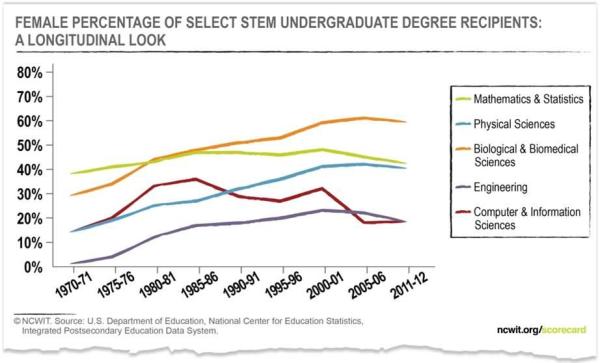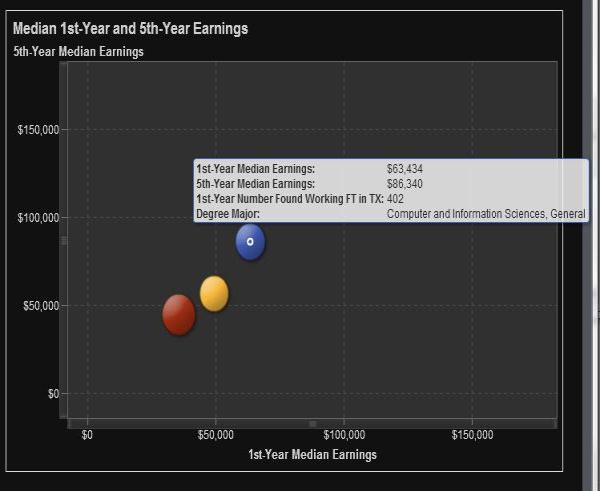Getting Girls into IT: Don't Blame Silicon Valley
Everyone is blaming Silicon Valley for the lack of women in IT when the blame lies squarely with females, including, author Cindi Howson explains, herself.
- By Cindi Howson
- October 7, 2014
Since Silicon Valley released their diversity numbers in June, I've watched the reactions with a mixture of optimism and dismay. As a woman in IT, the disclosures have heightened my hope that there will be a more concerted effort to improving diversity. However, I'm dismayed that everyone is blaming Silicon Valley when the blame lies squarely with the girls, present party included.
Girls are Leaving IT so the Boys Club Grows
Women once accounted for 37 percent of computer science degrees in the mid 1980s, to now less than 20 percent (source: NCWIT.org).

Yet people are crying foul about the low representation of women in high tech companies, particularly in technical jobs and leadership roles. Complainers are saying the Silicon Valley demographics should reflect their respective customer base. Is anyone demanding more female car mechanics simply because more women drive cars? I don't think so.
|
Company
|
Women in Tech Jobs
|
Women in Leadership
|
Women Overall
|
|
Apple
|
20%
|
28%
|
30%
|
|
Facebook
|
15%
|
23%
|
31%
|
|
Google
|
17%
|
21%
|
30%
|
|
Twitter
|
10%
|
21%
|
30%
|
|
Yahoo
|
15%
|
23%
|
37%
|
|
SAS
|
30%
|
35%
|
40%
|
Table 1. Source: http://pxlnv.com/blog/tech-company-diversity-stats/ and individual company websites.
Sparking an Interest Earlier
Part of the problem is that these next-generation companies say they represent a meritocracy, where all have equal opportunity and succeed on merit, versus the old-boys network. Frankly, I think there is an equal opportunity for women but not an equal interest or awareness.
My niece, who will be starting her degree in Computer Science at an east coast university this fall, is a prime example of why girls are not majoring in computer science. Jennie has always been a math whiz and gadget girl. She could command the table in poker and assemble a 1000-piece puzzle or Lego set faster than anyone. Until she began looking at colleges, however, she was never aware of computer science as a particular field to major in. A campus tour sparked her curiosity and led to her taking a class in computer science her senior year in high school.
It bothers me that her guidance counselor never before suggested the class. It also bothers me that she was but one of only three girls in a class of 14, a record high at the school, and very much consistent with the Silicon Valley demographics. How can we expect girls to major in computer science when we aren't introducing them to the subject in high school?
Even though I work in IT now, my path to business intelligence and big data has not been a direct one. I have always enjoyed and excelled at math, but my first passion was writing. As high school electives go, my high school did offer a computer science class back in the 1980s, but no way would I have opted for that over a writing class. For sure, neither my counselor nor parents ever recommended computer science as a way to use my analytic skills. It was only through writing classes in college and multiple crashes of the then new local area network that I learned how to recover those 50-page documents I was so desperate not to retype.
In my first job, writing and tracking proposals for a consulting company led me to discover Lotus 123, dBase, and personal computers. An avid reader, I devoured user manuals and my career hummed along, self-taught with a few vendor-specific certifications. Yes, those Novell Network Administrator manuals were as engrossing as a Ken Follett spy novel. I did eventually go back to school and get an MBA in management information systems; the rest is history.
Glimmers of Success
High tech firms are not to blame here. In part, I fault our education system for not exposing students -- girls and boys -- to computer science at an earlier age. Given that the U.S. education system is so poorly ranked in the basics of math and science, perhaps it's too much of a stretch for them to tackle technology, too. Here is where Silicon Valley can do more by offering after-school clubs and early camps to interested students.
A few groups have emerged in the last two years to address this challenge. For example, She++ started in 2012 at Stanford University for female computing engineers. She++ founder Ayna Agarwal was one of the Millenial speakers who kicked off SAP's Sapphire conference this year. Girls Who Code was also founded in 2012 and this summer offered camps in 19 tech companies around the country. Sponsors included some of those companies such as Twitter and Facebook that have recognized the diversity problem. Don't let the names of these organizations mislead you: coding is but only one possible job in information technology.
Although college students seem pressured to declare a major increasingly earlier in their secondary education, I've been impressed with those universities that guide students to their talents and to the job opportunities. The University of Texas System recently launched an application to provide prospective students, parents, and the public with access to data on degrees, salaries, and jobs. For example, the below bubble chart nicely shows the higher earnings for a grad in computer science (the blue bubble) versus an English major (the red bubble).

Silicon Valley could also take a page from software giant SAS, based in North Carolina. The company has long tracked its diversity numbers and been recognized as one of the best places to work by multiple rankings. Everything from flexible work hours to on-site gym and day care to keeping non-core jobs such as landscapers in house pays off in attracting talent across multiple demographics.
SAS does significantly better for women in tech and leadership roles (data for U.S.-based employees only; global data not reported due to international privacy laws), as the last row of figures in Table 1 show. At North Carolina State University, only about 9 percent of computer science graduates are women, so SAS actively works with the university to foster interest through an R3 summer student program: Recognize, Recruit, and Retain. Women and minority students have the opportunity to work on projects to gain real-world experience in analytics and technology.
The University of Miami also recently launched an initiative to pair current STEM college students with high schools in low-income neighborhoods. Students partner with high school teachers to enhance the curriculum, give guest lectures, and mentor high school students. ()
Hire a Girl ... or Not
Diversity is important for creativity and equal opportunity. Recognizing the problem is an important first step for companies recruiting and hiring, and the outcry from the published demographics has raised awareness. It's up to minorities -- however you define them -- to seize the career opportunity. Silicon Valley and high-tech firms can partner with universities and high schools to spark minorities' interest in such careers earlier in their education.
Ultimately, I don't ever want to be hired because I'm a woman. I only want to be hired because I'm good at my job. For that to happen, we have to foster a more diverse talent pool, beginning in high school. Silicon Valley has a vested interest in making that happen; so do the girls.